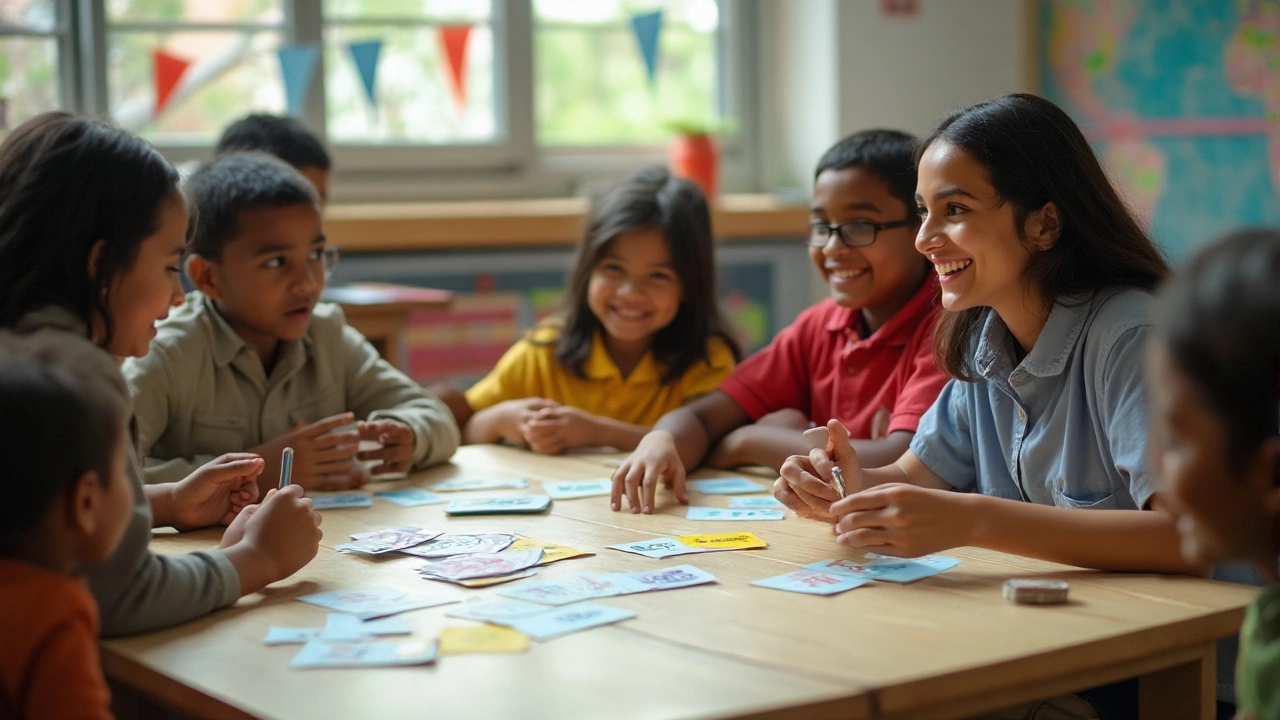Teaching English is more than just explaining grammar rules or memorizing vocabulary lists. It involves engaging students in a way that makes learning enjoyable and effective. Every learner is unique, with distinct preferences and ways of processing information. Understanding these differences is crucial to developing effective teaching strategies.
Interactive storytelling is a powerful tool that can transform the learning experience, making it both memorable and exciting. Coupling stories with language exercises helps students grasp complex concepts and retain them longer.
Immersive techniques, such as language immersion and cultural exposure, prove invaluable in teaching English effectively. These methods allow learners to experience the language in natural settings, promoting fluency and cultural understanding.
Playful learning, with activities and games, activates creativity and keeps students engaged. Creative tasks encourage exploration and experimentation, vital components of successful learning.
Lastly, using real-life scenarios in lessons bridges the gap between theory and practice. Applying classroom knowledge to everyday situations empowers students, helping them gain confidence in their language skills.
- Understanding Diverse Learning Styles
- Incorporating Interactive Storytelling
- Utilizing Immersive Techniques
- Engagement Through Playful Learning
- Applying Real-Life Scenarios
Understanding Diverse Learning Styles
Understanding the myriad ways people learn is fundamental in crafting an effective English learning experience. Each learner comes with a unique set of preferences, strengths, and challenges. One of the foundational theories in education is Howard Gardner's Multiple Intelligences, which posits that intelligence is not a single entity but a combination of several types, including linguistic, logical-mathematical, musical, spatial, bodily-kinesthetic, interpersonal, intrapersonal, and naturalistic. Acknowledging these different intelligences allows educators to tailor their teaching strategies to fit the diverse needs of their students.
For instance, linguistic learners thrive in activities involving reading and writing, and they often enjoy debates and storytelling. For these students, incorporating extensive reading materials and writing assignments into the curriculum can significantly boost their proficiency. Logical-mathematical learners, on the other hand, excel when they can analyze, organize, and synthesize information; thus, tasks involving problem-solving or pattern recognition could be more beneficial.
"The best teacher is not necessarily the one with the most knowledge but the one who can best uncover to their students where their strengths lie," said cognitive scientist Daniel Willingham.
Visual learners perceive information best when it is presented graphically. For these students, visual aids like diagrams, charts, and interactive digital tools can be immensely supportive. Meanwhile, auditory learners absorb information more efficiently through listening. Podcasts, group discussions, and oral presentations are effective tools for these learners. Tactile or kinesthetic learners benefit from a hands-on approach. Engaging them in role-plays, physical activities, or constructing projects can make learning more engaging and productive. Interpersonal learners, who thrive in social settings, excel in group activities and collaborative tasks. Conversely, intrapersonal learners, who prefer working alone, benefit from self-paced studies and reflective writing assignments.
Recognizing and appreciating these diverse learning styles is vital. In a classroom setting, teachers can use a mix of teaching methods to address these different styles, ensuring no student is left behind. This approach not only fosters inclusivity but also enhances the learning experience. Studies have shown that embracing diverse learning styles can increase student engagement and improve academic performance. In a multicultural classroom, customization goes beyond the learning style—it adapts to cultural nuances, adding another layer of understanding and respect. By weaving these strategies into English speaking courses, educators can unlock the full potential of their students, shaping a generation of proficient English speakers. For instance, incorporating project-based learning where students craft their narratives or imagine scenarios helps students apply language skills in practical, often creative settings.
Incorporating Interactive Storytelling
Interactive storytelling serves as a dynamic method for teaching English, linking the vibrancy of narratives to language learning. This approach engages students beyond the traditional grammar exercises and brings a living context to the lessons. When learners are captivated by a story, their attention naturally shifts to unraveling the language within it. Instructors can craft stories that align with the cultural backgrounds or interests of their students, which not only aids comprehension but also sparks curiosity about the English language. By integrating characters and settings that resonate with learners, the learning process becomes immersive and personal.
According to John Seely Brown, a thought leader in education, "Stories are important cognitive events, for they encapsulate, into one compact package, information, knowledge, context, and emotion." This illustrates how powerful storytelling can be in conveying complex ideas succinctly and memorably. Teachers can utilize the interactive element by pausing at crucial points in the story to ask thought-provoking questions. This encourages learners to predict outcomes, discuss hypotheticals, and delve deeper into understanding motives and perspectives, significantly enhancing their English proficiency.
Moreover, instructors are encouraged to leverage modern technology to amplify this experience. Digital platforms can host stories with layered elements such as voiceovers, sound effects, and visual aids that cater to different learning styles. For instance, a story projected on a screen with corresponding audio could transport students to another realm, making them active participants rather than passive listeners. Combining this with classroom discussions or group activities enables learners to assess and evaluate, fostering a deeper understanding and retention of the language. Interactive storytelling also offers opportunities for students to create and share their narratives, thus practicing language skills in an imaginative context.
Additionally, crafting an environment where students can co-create stories leads to collaborative learning. By involving learners in storytelling, teachers can facilitate an exchange of ideas among students, enhancing their critical thinking and English speaking abilities. Students who may struggle with traditional learning methods often find this approach liberating, as it allows them to express themselves beyond conventional language exercises. In this manner, interactive storytelling not only enriches the vocabulary but sharpens listening, speaking, and narrative skills, making it an all-encompassing experience.

Utilizing Immersive Techniques
Immersive techniques stand out as some of the most effective strategies in the realm of English learning, enveloping learners in experiences that mimic natural language acquisition. By creating an environment where English is the primary medium of communication, students are encouraged to think and respond directly in English, skipping the often cumbersome translation process. Immersion goes beyond traditional rote memorization, helping learners develop an intuition for the language that is deeply intertwined with cultural understanding. For example, language immersion programs in countries like England or the United States have shown tremendous success, allowing learners to practice in real-time, receptive and responsive to their environments.
Implementing immersive techniques can be as simple as incorporating English-language media into daily routines. From watching films with English audio to listening to music, these activities provide context and usage examples that are both entertaining and informative. Engaging with content in the target language pushes learners to think critically about conversations and narratives, promoting a natural acquisition of syntax and vocabulary. YouTube and streaming platforms host countless channels dedicated to educational content aimed at varying proficiency levels, giving learners a plethora of options to choose from.
"The best way to learn a language is to surround yourself with it and have fun," says Gabriel Wyner, a polyglot and author known for his book "Fluent Forever."
An immersive classroom setting might involve role-playing exercises that simulate everyday situations, such as ordering food in a restaurant or giving directions. These scenarios are beneficial not only for applying grammar and vocabulary but also for enhancing students' confidence in using the language practically. Educators might even incorporate cultural lessons into these exercises, offering students insights into the customs and etiquette associated with the English-speaking world. Pairing language learning with cultural understanding ensures that students appreciate the depth and diversity inherent to any language.
For those looking to formalize their approach, virtual immersion options are increasingly available. Platforms like Duolingo, Rosetta Stone, and Babbel offer comprehensive programs that emulate the natural language learning process through progressive lessons channeled within an immersive environment. Learners receive feedback instantly, bridging gaps in comprehension and correcting pronunciation. This shift towards digital immersion broadens access to language learning, enabling effective English study for those who might not have the opportunity to travel abroad.
A growing body of research supports the efficacy of immersive techniques in language acquisition. Studies published by various linguistic journals indicate a substantial improvement in language retention and fluidity among learners who engage in immersive learning compared to those who rely on traditional study methods. As education technologies and methodologies continue to evolve, immersion stands as a testament to the importance of experiential learning in mastering a language. The dynamic nature of this method fosters autonomy in learners, allowing them to take control of their language journey actively.
Engagement Through Playful Learning
When learning feels like play, the walls of resistance often crumble. The process of engaging students in a playful manner isn't just about distracting them; it goes much deeper, tapping into the natural curiosity that lies in every learner. Research has consistently shown that when students enjoy their educational experiences, they are more likely to absorb and retain information. Incorporating playful elements into teaching English is a way of harnessing learners' innate desire to explore, which in turn lays the foundation for lasting understanding. For many teachers, one of the most effective playful tools is the use of educational games, which can take various shapes and forms. From word puzzles that challenge students' vocabulary to board games centered around English language tasks, these activities provide immediate feedback and a sense of accomplishment upon completion.
In these sessions, students often forget they are learning — they are competing, collaborating, and using the English language as a tool for interaction, rather than as a subject. This social aspect of learning is significant because it develops not only academic skills but also interpersonal ones. Creating a safe, unintimidating learning environment is crucial and playful learning does just that. Students naturally engage and interact, boosting their motivational levels and sparking their analytical and critical thinking skills. A positive emotional context also reduces anxiety, which is a known barrier in language acquisition.
Cara Lucas, in her seminal work on educational psychology, notes, “Playful learning leads to a deeper emotional connection, unlocking the potential for real engagement and creativity in language education.”
Role-playing exercises are another playful technique that serves as a dynamic way to reinforce English learning. Beyond mere fun, role-play encourages learners to put themselves in different shoes—enabling them to use new vocabulary and structures in context. It nurtures empathy, flexibility, and spontaneous use of language, which is helpful for mastering fluency. Whether it’s acting out daily activities, dramatizing a historical event, or imagining future scenarios, these exercises compel students to think on their feet, engage in problem-solving, and develop narratives, all critical skills when learning a new language.
Educational technology offers another exciting venue for playful learning. There are countless apps and online games designed specifically for teaching English. These tools can offer personalized learning experiences, adapting in real-time to meet the needs and skill levels of individual students. Many of them incorporate elements of storytelling, puzzles, and quizzes, combining cognitive challenges with gamified rewards, such as badges and points, to motivate learners and keep them invested over a longer period.
According to a 2023 survey conducted by the Global Language Education Forum, 72% of educators reported increased engagement levels in language courses that incorporated game-based learning methods. The data underscores a growing realization among educators that play isn't just a pastime—it’s a powerful vehicle for effective learning. Embedding playful learning into course structures not only enhances engagement but also transforms the educational experience into something students eagerly anticipate, making it a cornerstone approach in English learning.

Applying Real-Life Scenarios
One of the most effective methods for teaching English is to tie the language lessons directly to real-life scenarios. This approach resonates with learners as it allows them to see the tangible benefits of acquiring new language skills. By embedding lessons in realistic contexts, students can practice speaking, listening, reading, and writing in ways that mimic everyday situations. Real-life scenarios have the power to make learning more relatable and significantly boost a student’s confidence and motivation. Imagine teaching the concept of shopping vocabulary by organizing a mock shopping experience in class. This not only aids in retention but makes the vocabulary practical and useful for future interactions in English-speaking environments.
Consider using role-play exercises to simulate job interviews, where learners can practice both industry-specific language and interpersonal communication skills. Role-plays provide a safe environment to make mistakes and learn, and they also help to ease anxiety about using English in real-world situations. By engaging students in these scenarios, not only is their skill in the English language exercised, but their problem-solving ability and critical thinking are also improved. According to a study published by the Journal of Educational Psychology, role-play exercises can increase language retention by up to 30% compared to traditional lecture methods.
An interesting way to apply English learning in real-world contexts is through project-based learning (PBL). In PBL, students might work on a group project to create a news segment or a community newsletter, which encourages collaboration while honing their English proficiency. Projects like these require students to research topics, gather information, and articulate their findings in English. It shifts the learning experience from passive absorption of information to active production and communication in English, enhancing the depth and breadth of their language skills.
Using real-life scenarios also brings cultural insights into the classroom, which is invaluable in language courses. Teaching students about customs, traditions, and societal norms of English-speaking countries can be done effectively through exploration of real-life events. Whether it’s through cooking traditional dishes, discussing current events, or celebrating international festivals, students gain context for their language learning journey. As per education expert John Dewey, "Education is not preparation for life; education is life itself." By inviting the world into the classroom, learners are better prepared to step out into it with confidence.
In applying real-life scenarios, technology can be a great ally. Leveraging tools like virtual reality or augmented reality can transport students to English-speaking locales instantly. These technologies allow learners to experience scenarios like touring a city or attending a virtual conference, offering immersive and practical language encounters. For example, using a VR headset to practice giving directions in an English-speaking city can provide valuable hands-on experience that a textbook can't match.



